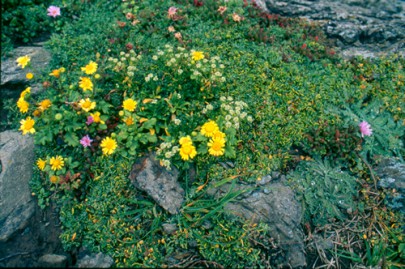Seabird guano deposits
In this section

Rare native plants on seabird nesting sites, South Brothers Island (Shannel Courtney)
Nesting sea birds deposit guano (excrement) that can accumulate to form deposits of varying depth. These areas commonly have sparse vegetation because of bird trampling and the toxically high nitrogen status of fresh guano, but towards the edges, in sparse colonies or on shallow deposits, vascular plants can occur (Gilham 1960). Halophytic plants such as native ice plant (Disphyma australe), native shore groundsel (Senecio lautus), and Einadia trigonos are the most common. Green algae are also associated with guano, like the recently discovered species from the order Prasiolales (Prasiola novaezelandiae) (Heesch et al. 2012). Outside the breeding season, when the birds are absent and rain has washed some areas free of guano, there is likely to be a minor invasion of annual exotic weeds that can cope with the high nutrient status. These communities grade into other coastal communities such as coastal turfs.
Notable flora and fauna
Threatened plants include the nationally critical coastal peppergrass (Lepidium banksii). Nationally vulnerable species include Kirkianella novae-zelandiae, Lepidium naufragorum, nau (Lepidium oleraceum), New Zealand water cress (Rorippa divaricata) and Chatham Island forget-me-not (Myosotidium hortensia). Recovering species include Chatham island sow thistle (Embergeria grandifolia). Relict species include Chatham Island button daisy (Leptinella featherstonii), Chatham Island groundsel (Senecio radiolatus subsp. radiolatus) and guano groundsel (Senecio sterquilinus). Declining species include shore cress (Lepidium tenuicaule). Naturally uncommon species include (Anisotome latifolia), Buchanan’s orache (Atriplex buchananii), Cox’s fescue (Festuca coxii), Leptinella lanata, L. plumosa, Pleurophyllum criniferum, Antipodes groundsel (Senecio radiolatus subsp. antipodus), Stellaria decipiens var. angustata, Chatham Islands poa (Poa chathamica), muttonbird poa (Poa foliosa) and Poa ramosissima.
During their nesting season, burrowing seabirds such as petrels, prions, and shearwaters share their burrows with the threatened ancient reptile, the tuatara's (Sphenodon punctatus). The seabirds' guano helps to maintain invertebrate populations that are a primary food source for the tuatara, including beetles, crickets, and spiders.
Threat status
Critically endangered (Holdaway et al. 2012)
Threats
Seabird colonies (except for black-back gulls, which have increased since European colonisation) are threatened by predation by invasive mammals and domestic pets, disturbance from grazing stock, off-road vehicles and people, and encroaching urbanisation. Exotic weeds are present, but with the exception of the grasses mentioned above, these are mostly transient.
Where do they occur?
The largest guano deposits are found in association with Australasian gannet (Morus serrator) colonies that have been occupied for decades. The most extensive of these is on the North Island at Cape Kidnappers, Hawke Bay. They also occur also on several offshore islands, e.g. White Island/Whakaari and on coastal rock stacks. A large red-billed gull (Larus novaehollandiae ssp. scopulinus) colony occurs at Kaikoura, and large black-backed gull colonies can occur inland, e.g. Mt Tarawera dome tops where colonies are densely vegetated by exotic grasses, e.g. sweet vernal (Anthoxanthum odoratum), Yorkshire fog (Holcus lanatus). Smaller localised deposits are associated with shags and little blue penguins, which are common around much of the coastline.
Further reading
Gillham ME 1960. Plant communities of the Mokohinau Islands, northern New Zealand. Transactions of the Royal Society of New Zealand 88: 79-98.
Gillham ME 1960. Vegetation of tern and gannet colonies in northern New Zealand with a comparative note on colonies in the Bass Strait, Tasmania. Transactions of the Royal Society of New Zealand 88: 211-234.
Hawke DJ, Clark JM, Vallance JR 2012. Breeding Westland petrels as providers of detrital carbon and nitrogen for soil arthropods: a stable isotope study. Journal of the Royal Society of New Zealand, DOI:10.1080/03036758.2011.616211.
Heesch S, Sutherland JE, Nelson WA 2012. Marine Prasiolales (Trebouxiophyceae, Chlorophyta) from New Zealand and the Balleny Islands, with descriptions of Prasiola novaezelandiae sp. nov. and Rosenvingiella australis sp. nov. Phycologia 51: 217-227.
Hogg EH, Morton JK 1983. The effects of nesting gulls on the vegetation and soil of islands in the Great Lakes. Canadian Journal of Botany 61: 3240-3254.
Norton DA, Delange PJ, Garnock-Jones PJ, Given DR 1997. The role of seabirds and seals in the survival of coastal plants: lessons from New Zealand Lepidium (Brassicaceae). Biodiversity and Conservation 6: 765-785.
Links
Seabird ecology (DOC Southern Seabird Solutions)
The Gulf of Seabirds (Great Barrier Island Charitable Trust)
Guano (Wikipedia)


